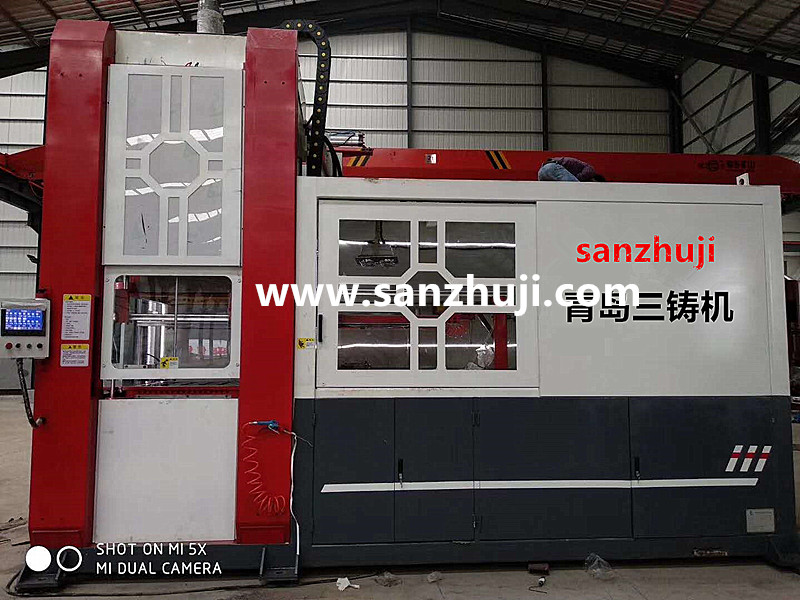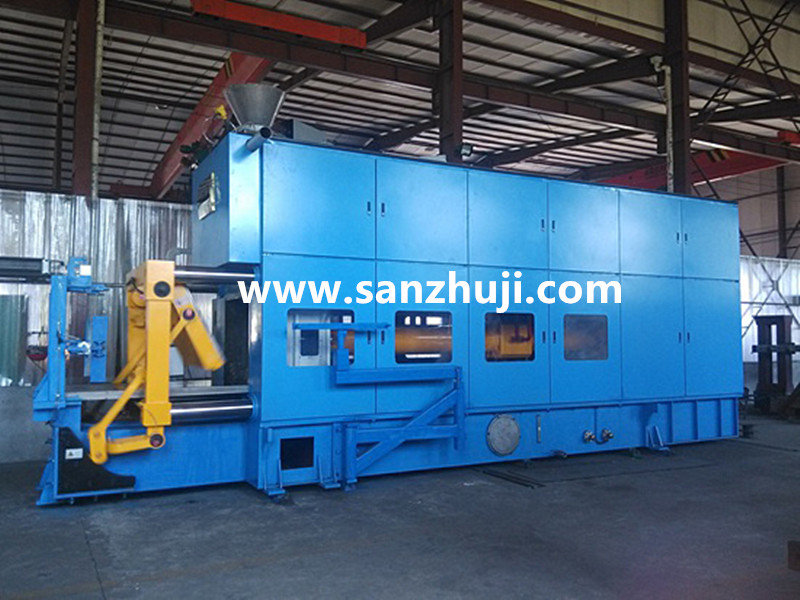6. Poor carburizing, sulfurizing and spheroidization
In low-carbon steel and low-carbon stainless steel, carburization of the surface layer of castings will occur, and the carburized layer can reach a depth of 2 to 3 mm. When sulfonic acid curing agents are used, there may be on the surface of cast steel, stainless steel or ductile iron. The sulphurized layer of 1~2 mm causes poor spheroidization or performance deterioration. Sanzhuji combined with Self-hardening Sand Reclamation Systems to give the following preventive measures:
6.1 The way to solve the carburizing problem is to add an appropriate amount of iron oxide and other suitable oxidizers to the cast coating, or use chromite sand molds and double-layer coatings to reduce the depth of the carburized layer.
6.2 In order to prevent sulphurization, a variety of special coatings containing powerful desulfurizers have been developed. For ductile iron, the amount of spheroidizing agents should be appropriately increased.
7. The dimensional accuracy of cast iron is out of tolerance
Resin sand casting molds can improve the dimensional accuracy of castings, but in actual production, the castings are scrapped due to the excessive size of castings. The reasons are as follows:
7.1 Deformation of model or tooling. Generally speaking, wood molds are sufficient for resin sand models, and if the wood molds are not dry enough, they will often deform with temperature changes.
7.2 When the clay sand model or tooling is transferred to resin sand for use, the core gap and the negative parting number are not reduced. If the shrinkage is not adjusted properly, core drifting and fire running during pouring will affect the dimensional accuracy of the casting. The shrinkage rate of resin sand should be determined based on actual measurement. At the same time, pay attention to the difference between the shape and the core, the difference in the resistance of each part, and the comparison test should be carefully carried out. Fortunately, the reproducibility of the same size of this mold is very good, and it is not difficult to grasp the shrinkage law.
7.3 Improper modeling and mold assembly operations, loose model positioning, etc. will cause dimensional errors. For very demanding sizes, even the thickness of the paint layer will affect the accuracy.
8. Resin sand casting production
Since self-hardening resin sand casting has the advantages of good surface quality, high dimensional accuracy, low rejection rate, wide application range, low technical level of workers, greatly reducing the labor intensity of workers and improving the working environment, the domestic More and more companies (or enterprises) choose self-hardening resin sand casting methods. Although the self-setting resin sand casting technology has matured, there are still many problems in the production process.
In the production process of self-setting resin sand casting, the following issues need to be paid attention to.
8.1 Always pay attention to the operation of the equipment
The operating condition of the equipment directly affects the cost of casting production and the quality of castings. Therefore, in casting production, we must always pay attention to the operating conditions of the equipment, and analyze and solve abnormal operation in time, focusing on the following two aspects:
8.11 Pay attention to the operation of dust removal equipment. The quality of dust removal equipment directly affects the regeneration cost of reclaimed sand and the quality of castings. In casting production, it is often difficult to find abnormal operation of dust removal equipment, but if the dust removal effect of dust removal equipment is not good, it will not only It affects the working environment, pollutes the air, and more importantly, affects the fine powder content of the reclaimed sand. The direct result is an increase in the amount of resin added during sand mixing and an increase in the casting rejection rate due to poor air permeability.
8.12 Pay attention to the operation of sand mixing equipment Whether the sand mixer can operate normally or not directly affects the quality of sand mixing. Among them, the amount of liquid material (resin, curing agent) added is the most important. In general, the amount of resin added is achieved by controlling the voltage of the gear pump motor, and the amount of curing agent added is achieved by controlling the voltage of the diaphragm pump motor. Due to the change of seasons and weather, the viscosity of the liquid material changes. In the case of voltage, the amount of liquid material added will fluctuate, and the curing agent is easy to crystallize, causing valve and pipeline blockage. Therefore, the liquid material pipeline should be cleaned every shift, and the amount of liquid material added should be tested every week. To ensure the accuracy of the liquid material added.
8.2 Pay attention to the correctness and rationality of the formulated production process
Whether the production process is reasonable or not directly affects the casting yield, casting quality and casting cost. When formulating the production process, the following items should be paid attention to:
8.21 Determine the LOI value of suitable reclaimed sand
LOI value, i.e. ignition loss, is an important index to measure the release rate of reclaimed sand, and it is also an index closely related to the amount of gas evolution of molding sand and the occurrence of pore defects in castings. Cast iron parts are generally produced with furan resin sand. Practice has proved that LOI value control About 3% can fully meet the production requirements, and excessively reducing the LOI value is of little significance.
8.22 Determine the appropriate casting process parameters
8.221 Determine the appropriate final strength Generally, after the resin sand is mixed, it will harden itself for about 24 hours to reach the highest strength, that is, the final strength. Due to the different production conditions and production scales of various enterprises, the time interval from modeling to pouring does not necessarily exceed 24 hours, so the final strength should be determined by the enterprise. For small-scale enterprises that implement a furnace system for a few days, the 24-hour final strength standard can be used; for those with a mold curing time of less than 24 hours, the final strength standard is the strength achieved before pouring. At the same time, there are two tendencies to overcome in production: on the one hand, blindly increase the strength to ensure quality, which increases the cost of casting and cause waste; on the other hand, lower the strength to ensure the cost, resulting in unstable quality and fluctuation range. Large, so that the quality of castings is greatly affected by raw materials and operators.
8.222 Determine the appropriate sand-to-iron ratio Since the self-setting resin sand has high strength, mold release after curing, and flat parting surface, its sand consumption is smaller than that of clay sand, but its sand-to-iron ratio also has certain requirements. If the foundry sand-to-iron ratio is too high, both resin and curing agent will be wasted during the production process, and larger waste sand blocks will be produced, which will increase the burden on the reclaimer, reduce the release rate, increase the LOI value, and increase the possibility of porosity in the casting. Large; if the sand-to-iron ratio is too low, it is easy to run out of fire during pouring and the casting is easy to deform. According to our experience, the ratio of sand to iron should be chosen to be 2.2~3:1.
8.223 Determine the appropriate pouring system Furan resin sand has poor thermal stability. According to data, when the amount of resin added in resin sand is 1.4%-1.6%, its thermal stability is the best, but in general, resin is added The amount is about 1.2%. Therefore, the design principle of the pouring system is to ensure that the molten metal fills the mold cavity quickly and smoothly within the thermal stability of the resin. Therefore, when determining the pouring system, ceramic tubes should be used as much as possible, and Make the inner gate more and scattered.
8.31 Selection of raw sand
Raw sand is divided into ordinary sand, water-washed sand, scrubbing sand, etc. Since the mud content in scrubbing sand is already very small, it can greatly reduce the waste of resin. It should be selected first, followed by water-washed sand, but it must not be used. Processed raw sand. When choosing molding sand, one must follow the principle of nearby selection to reduce transportation costs, and second, try to choose raw sand with low angle coefficient.
8.32 Selection of resin
The choice of resin directly affects the casting quality. If a poor quality resin is selected, it will not only increase the amount of resin added, but also affect the quality of the molding sand, resulting in more casting waste. Therefore, the choice of raw materials should not be determined based on the technical data provided by the manufacturer, but should be determined by the manufacturer. Have a good understanding of the production equipment, production process and quality control methods, and try to test the various indicators of the resin by yourself or ask the relevant reputable inspection department for inspection, or learn from the experience of similar manufacturers, or choose the reputation Good products from well-known large companies.
8.33 Selection of other raw materials
Other raw materials include curing agents, coatings, adhesives, mold release agents, sealing mud sticks, etc. The selection of these raw materials should not only consider their quality issues, but also consider their matching with the main materials, such as procurement and convenient transportation. . Because the impact of these raw materials on the quality of castings is not the main one, but the impact on the casting cost cannot be ignored. For example, the difference in the amount of curing agent added not only affects the production cost due to the production efficiency of the molding process, but also affects the material cost.
In short, as long as the above aspects are paid attention to, not only castings that meet customer requirements can be produced, but also casting costs can be reduced, bringing development and benefits to the enterprise.
Qingdao Sanzhuji Equipment Manufacturing Co., Ltd. specializes in the production of sand reclamation equipment,foundry machines,Sand casting equipment,GS high efficiency rotary mixer,no-bake resin sand mixer,Jolt squeeze molding machine/Jolt-squeezing moulding machines,Multi- Piston Moulding Machine/Hydraulic multi-piston moulding machine,foundry molding machine,flaskless moulding machine,shot blasting machine,dust collector,according to the amount of old sand recovered Carry out plan customization, and provide sand reclamation equipment installation, commissioning, and training. Welcome guests to visit the factory.








